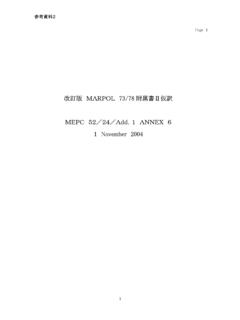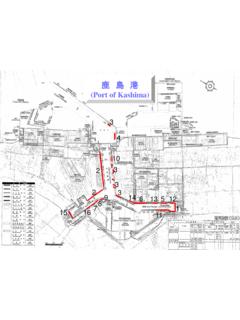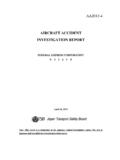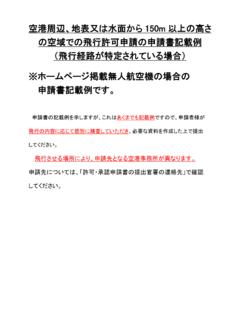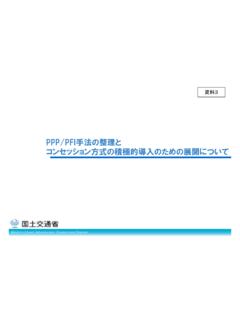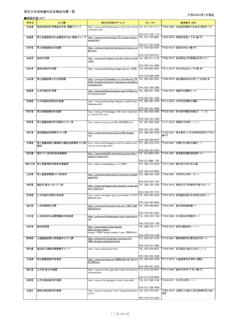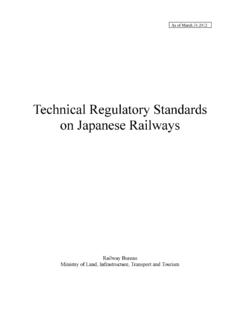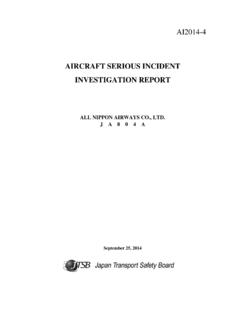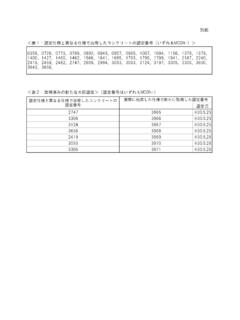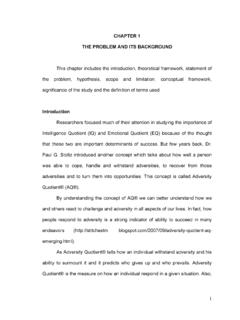Transcription of ANNEX 1: PROBLEM DEFINITION AND BACKGROUND …
1 FSA STUDY ON BULK CARRIER SAFETY CONDUCTED BY JAPAN MSC75/5/2. ANNEX 1. Page 1. ANNEX 1: PROBLEM DEFINITION AND BACKGROUND information . 1. DEFINITION of the PROBLEM DEFINITION of the PROBLEM SOLAS Chapter XII requires safety measures to those bulk carries of length of 150 m and over and which carry high-density bulk cargo. The Committee is discussing questions whether safety measures are necessary for bulk carriers to which Chapter XII does not apply. This FSA study is intended to give assistance, by FSA methodology, for verifying and analyzing the safety of bulk carriers to which Chapter XII does not apply. For this purpose, this evaluation needs to compare the safety of various types of bulk carriers that comply with SOLAS Chapter XII or does not comply with that. Ship category DEFINITION of Bulk Carriers There are several definitions of bulk carriers. These are: .1 A DEFINITION of bulk carriers is given in SOLAS Chapter IX; that is, Bulk Carrier means a ship which is constructed generally with single deck, topside tanks and hopper side tanks in cargo spaces, and it intended primarily to carry dry cargo in bulk, and includes such types as ore carriers and combination carriers.
2 2 Another DEFINITION has been developed during the SOLAS Conference and is given in the Conference Resolution 6; that is, Ships constructed with single deck, topside tanks and hopper side tanks in cargo spaces and intended primarily to carry dry cargo in bulk; or ore carriers; or combination carriers ..3 The other DEFINITION has been proposed by MSC 70/4 which has proposed FSA study on bulk carriers; that is, A bulk carrier is any ship designed, constructed and/or used for the carriage of solid bulk cargo.. For the purpose of this study as mentioned in , a wider DEFINITION should be used. Therefore, the study is based upon the third DEFINITION (mentioned in ). In relation to these definitions, solid bulk cargo should be defined and this is given in SOLAS. Chapter XII Regulation as follows;. Solid bulk cargo means any material, other than liquid or gas, consisting of a combination of particles or larger pieces of material, generally uniform in composition, which is loaded into cargo spaces of a ship, generally without any intermediate form of containment.
3 Type of Bulk Carriers , Ship Size and Ship Age A preliminary investigation on type of bulk carriers and their categorization method was carried out. APPENDIX A DEFINITION AND IDENTIFICATION OF BULK CARRIERS FOR FSA of this report shows the investigation results. Based on this investigation results, it was decided that Table of FSA STUDY ON BULK CARRIER SAFETY CONDUCTED BY JAPAN MSC75/5/2. ANNEX 1. Page 2. APPENDIX A would be used for categorization of bulk carriers. Types of bulk carries, which meet the DEFINITION given in and categorization in Table of APPENDIX A, have been derived from ship register of Nippon Kaiji Kyokai (ClassNK). Actual possible sizes of bulk carriers of each type are also selected. These types and their size are shown in APPENDIX B. Type Distribution of NK registered Ships Carrying Solid Bulk Cargo . APPENDIX B illustrates the typical mid-ship section of the hold of each type of bulk carriers. APPENDIX B also gives possible cargoes to be carried in the column of purpose of ship.
4 Types of (1'), (4') and (5') has been deleted from the consideration because actual number of the ships of these types are very small, and ships of such types are no longer built. APPENDIX C gives a general plan of hull construction of bulk carriers. APPENDIX C also gives detail of components and elements of construction and structure, as well as fundamental equipment, of bulk carrier type (1), (2) and (3). Hazard relating to these components and elements should be identified in FSA. Step 1 hazard identification process. Ship age will be considered at casualty data analysis and taken into consideration in analysis in FSA. STEP 1 to STEP 5. Tentatively, two class of ship age is chosen as;. (1) from 0 up to 15; and (2) from 15 and over. Type of Cargo APPENDIX D describes the types of cargo that are intended to be carried by each type of bulk carriers which is categorized in APPENDIX B. Actual practice of cargo carriage by each size of bulk carrier is surveyed and the results are given in of APPENDIX D.
5 These data should be considered in FSA. Step 1 hazard identification process. Ship functions and features This study deals with problems particular to bulk carriers. Therefore, in general, this study deals with cargo area and forecastle of bulk carriers, and does not deal with machinery spaces and accommodation spaces, because arrangements in machinery spaces and accommodation spaces of bulk carriers are almost the same of those of other type of cargo ships. Detail of components and element of construction and structure, as well as major equipment, of typical bulk carriers are shown in APPENDIX C. However, following functions, facilities and items have been tabled to the discussion of the Committee at its 69th and 70th session, and may be considered as risk control options (RCO): - Redundancy of steering systems - life-saving appliances including evacuation systems and free fall lifeboat - means of communication of alert signal to rescue parties - hatch cover (operation, maintenance and strength).
6 - access to fore end spaces (necessity of consideration, safety). - communication systems between bridge and fore end spaces (necessity of consideration). FSA STUDY ON BULK CARRIER SAFETY CONDUCTED BY JAPAN MSC75/5/2. ANNEX 1. Page 3. - loading computer - facilities and equipment mentioned in the report of Derbyshire (bulge alarm, lighting in fore end spaces;). - tank sounding systems, bilge alarm systems, emergency pumping in fore end spaces - facilities and equipment particular to bulk carriers Operating Condition Operating conditions of bulk carriers have been categorized. Table gives the selected operating conditions that should be considered in this study. Table Operating conditions to be considered Loaded voyage Ballast voyage others voyage with condition of voyage with condition of: loading at port - homogeneous loading - normal ballast unloading at port - homogeneous loading of high density cargo - heavy ballast - alternate loading of high density cargo (Ballast exchange at sea in these - loading for two port unloading (there are many cases should be included.))
7 Pattern of loading) or partial loading/unloading - irregular alternate loading (block loading). - slack loading Reference: Bulk Carriers Guidance and information on Bulk Cargo Loading and Discharging to Reduce the Likelihood of Over-stressing the Hull Structure, IACS. Human Factors Safety management of operation of bulk carriers is regulated by SOLAS Chapter IX and ISM Code. This study uses an assumption that the safety management of bulk carrier is kept in good condition according to the SOLAS regulations and ISM Code. However, following items should be considered in this study, because these may affect on safety in case of various operation conditions. (1) On-board human factor, such as on board maintenance, navigation and operation in normal condition and emergency condition (2) Ship management, manning management and navigational management, and (3) Safety management. APPENDIX E illustrates typical chartering system and voyage patterns.
8 External Influences on the ship Weather and sea conditions Weather and sea conditions affect directly the safety of bulk carries. Techniques for prediction of sea conditions have been developed and available world wide, in Proceedings of the 13th International Ship and Offshore Structure Congress (ISSC 1997). Then, it is anticipated that height of wave or green water coming on deck as well as consequential water load can be calculated. These techniques will be used on this study. FSA STUDY ON BULK CARRIER SAFETY CONDUCTED BY JAPAN MSC75/5/2. ANNEX 1. Page 4. Accident category The scope of the study is to deal with safety of bulk carriers. Therefore, accident particular to bulk carriers should be considered. Accidents of bulk carriers have been classified into two categories;. (1) Casualties to be dealt with, because these are particular to bulk carriers, and (2) Casualties not to be dealt with, because these are not particular to bulk carriers.
9 Table show the results of categorization. Table Categorization of Casualties Casualties to be considered in this study Casualties not to be considered - Fire and explosion in cargo hold and fore end spaces - Personnel accident - Flooded - Fire and explosion in machinery and - List and capsize accommodation spaces - Founder - Collision and contact - Damage and break down of construction and facilities - Ground and strand in cargo hold and fore end spaces Risk associated with consequences Scope of this study is safety of bulk carriers, and particularly safety of life on bulk carries. Therefore, risk for life is the major concern. This study does not deal with business risk and risk to environment. Reference to the Regulations (1) International Convention for the Safety at Sea, 1974 as amended (SOLAS 1974) and the relative Protocol, especially, (a) Chapter XII - Safety Measures for Bulk Carriers, including IACS Unified Requirements S12.
10 And S17 to S24. (b) Chapter XI - Enhanced Survey, and IMO Resolution (18). (c) Chapter IX - International Safety Management Code (ISM Code). (d) Chapter III - Life-Saving Appliances and Arrangements (e) Chapter II-2, VI and VII - Code of Safety Practice for Solid Bulk Cargoes as amended (BC. Code). (f) Chapter II-2 and VII - International Maritime Dangerous Goods Code as amended (IMDG. Code). (2) International Convention on Load Line, 1966 (ILL 66) and the relative Protocol (3) International Convention for the Prevention of Pollution from Ships, 1973 as amended (MARPOL. 73) and the relative Protocol (4) International Convention on Standards of Training, Certification and Watchkeeping for Seafarers, 1995 as amended (STCW). DEFINITION of the generic model Generic bulk carriers are described in and APPENDIX B and C. FSA STUDY ON BULK CARRIER SAFETY CONDUCTED BY JAPAN MSC75/5/2. ANNEX 1. Page 5. 2. BACKGROUND information BACKGROUND information regarding ship types, cargoes and operation is given in APPENDIX A, B, C, D and E.
